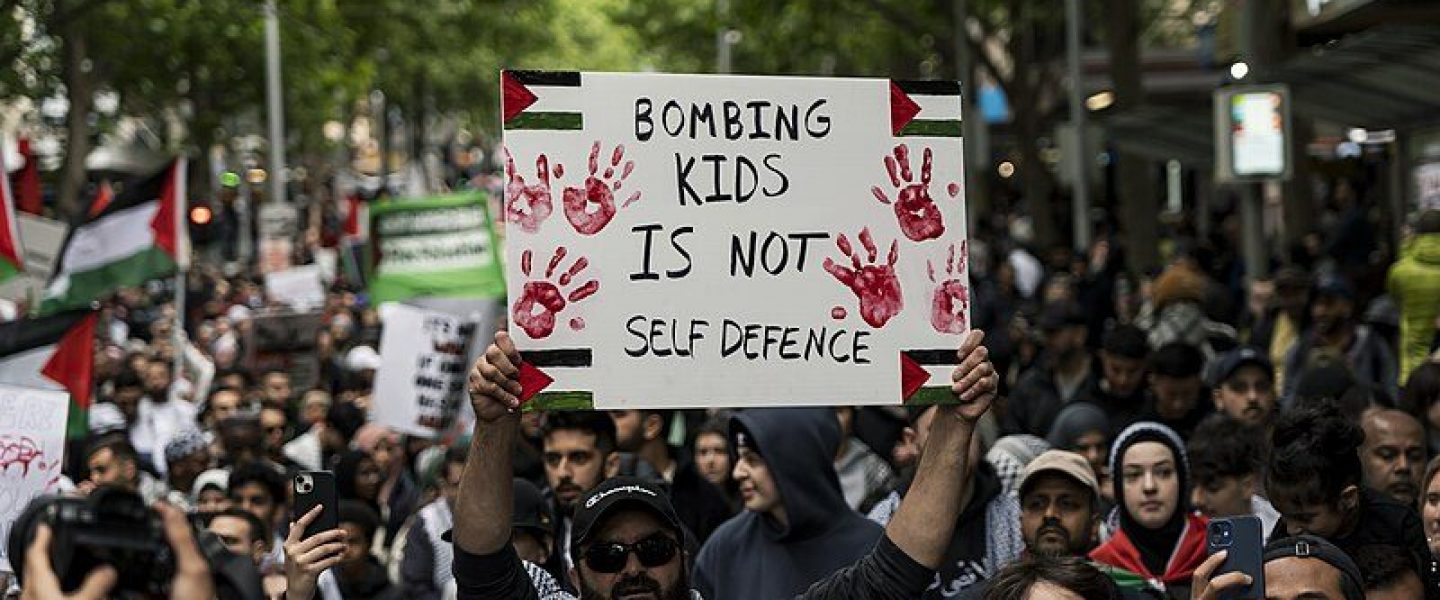Concern for hostages and the impact of fighting on civilians fail to slow Israeli attacks in Gaza.
|
Listen To This Story
|
It took just three weeks for Israel’s public image to change from victim of Hamas’s inhuman slaughter to aggressor bombing innocent Palestinian women and children in Gaza. That has done nothing to stop Israel’s determination to eliminate Hamas’s presence in Gaza.
The shift in public perception, however, has left even US pledges of unconditional support dangerously fractured. The implications may reach farther than Israel’s problems with Hamas. Jewish communities around the world have already sensed an upsurge in antisemitism.
Despite the negative criticism and growing protests in Europe and the US, Israeli troops and armor launched a new incursion into Gaza Friday night. Communications were cut with the outside world as airstrikes against Hamas’s underground bunkers and tunnels intensified and Israeli troops have remained inside Gaza. Prime Minister Netanyahu told Israeli hostage families that eliminating Hamas is his top priority and that freeing the hostages came after that.
The dramatic change in Israel’s image is due largely to its unprecedented bombing campaign, which has launched up to 400 airstrikes in a single day, terrorizing the enclave’s overcrowded urban landscape. Gaza’s health ministry issued a 212-page document on Thursday that listed the names of nearly 7,000 Palestinians, along with their ID card numbers, who it claims were killed in the bombing. The ministry is controlled by Hamas, which raises questions about the report’s credibility; but, accuracy of reported numbers aside, the bombing campaign has flooded the internet with graphic images of whole apartment blocks blasted into rubble.
Virtually the entire Islamic world, along with the rest of the planet, is being exposed on a daily basis to an unending succession of photographs and videos showing terrified women and children bleeding from horrific wounds, all of it inflicted by Israel.
Reactions to this flood of information can differ wildly depending on whether you are exposed to Israeli, American, or Arab news coverage. The overall situation is further complicated by the fact that some images have been faked to make the situation look even more grotesque. That is compounded by the fact that Arab audiences are usually primed to believe the worst about Israel. All of that can lead to a radically different understanding of what is actually taking place and what to do about it.
Although Israel claims to have already killed some important members of Hamas, it’s questionable whether the cost is worth it. The bombing has almost certainly killed more civilians who had nothing to do with Hamas’s attack than it has members of Hamas.
The Israeli military is well aware that, unlike the ordinary citizens of Gaza, Hamas’s military wing can shelter in an extensive maze of underground tunnels and bunkers that no doubt enabled them to wait out the bombing in relative safety.
Virtually the entire Islamic world, along with the rest of the globe, is being exposed on a daily basis to an unending succession of photographs and videos showing terrified women and children bleeding from horrific wounds, all of it inflicted by Israel.
During the Vietnam War, US Special Forces A-teams routinely built similar tunnels under their firebases and, as a last resort, called in B-52 strikes on their own positions when they were about to be overrun. Despite the extreme violence of the B-52 strikes, most US troops in the tunnels survived. The bombing in Gaza seems more effective at soothing the blind rage that Israel experienced after Hamas’s attack. Getting Israel to overreact by killing thousands of civilians may have been Hamas’s intention all along.
Israel’s insistence on cutting off water, electricity, and food for Gaza’s nearly 2.3 million inhabitants has not helped Israel’s image problem. The tactic has closed most of Gaza’s hospitals, many of which ran out of anesthetic days ago. Israel’s refusal to allow fuel into Gaza is apparently aimed at preventing Hamas from using the fuel to pump fresh air into its underground tunnel complex.
The reaction among the 456 million Arabs who populate the Middle East has been a resurgence of outrage against Israel’s very existence. While the US remains committed to Israel’s survival, there is a growing sense that the crisis engineered by Hamas is beginning to spin out of control and will eventually damage US interests throughout the region.
In a worst-case scenario, rage and intemperate reactions on both sides could result in a regional — and possibly global — confrontation that might easily turn nuclear.
To prevent that, the US has already stationed two aircraft carrier battle groups in the eastern Mediterranean and it has activated a Terminal High Altitude Area Defense (THAAD) battery. Additional Patriot battalions have been dispatched to US bases throughout the area along with an additional 900 troops to maintain them. At least 2,000 US Marines are being kept on stand-by alert, and an additional squadron of F-16 Falcon aircraft arrived on Tuesday.
Subhed
The US has asked Israel to delay launching a massive ground operation into Gaza long enough to reinforce American bases. But the real fear is that serious combat in Gaza could lead to a major escalation that reaches beyond Israeli territory. Pressure is also mounting in Israel to hold off on a massive assault as long as there is some hope of freeing more hostages
A sudden upsurge in drone and missile attacks against American installations in Syria and Iraq has already wounded at least 19 US servicemen and left several with traumatic brain injuries. The US responded with airstrikes against Iranian-backed militia groups in Syria.
American citizens were advised earlier in the week to leave Lebanon, where 100,000 heavily armed Hezbollah fighters present an ongoing threat. The American Embassy in Kuwait received threats over social media from Iraq and promptly canceled all nonessential functions. A noticeable increase in drone and missile attacks directed against American installations has occurred across the region.
Turkey — an important member of NATO primarily because it provides access to the “soft underbelly of Russia,” as well as a home for key US air bases covering central Asia — has begun to publicly express sympathy for Palestinians caught in the crossfire. China and Russia joined forces to veto a UN Security Council resolution that would have encouraged a pause in Gaza to enable aid and food to be brought in. Major players clearly feel they have something to gain from the continuing chaos.
Subhed?
The current series of events, in fact, bears an unsettling similarity to the multipolar misalignment that led to the outbreak of World War I. At that time, the lack of global leadership, combined with a series of interlocking defense pacts, turned the assassination of Austria’s Archduke Ferdinand into the trigger for an escalating conflict that killed an estimated 20 million people.
Today it is hard to remember the events that actually led to the conflict, but everyone knows the cost. It destroyed an entire generation of young men; drove both sides to unprecedented acts of inhumanity, including the use of poison gas; and laid the groundwork for World War II, which proved even more devastating. Caught up in reacting to specific events, the public for too long failed to see the larger picture and the self-destructive direction in which the combatants were headed.
Historians caution that we could be witnessing a similar phenomenon now. Hamas’s attack put the Abraham Accords — the pact that would have eventually cleared the way for increased cooperation between Israel and Saudi Arabia — on semipermanent hold. A major question is whether the initiative to sabotage the prospective deal came from Hamas or from Iran. The truth is that we really do not know.
What we do know is that, according to an exclusive report in The Wall Street Journal, 500 members of Hamas received commando training in Iran a month before the October 7 attack. When Hamas burst into Israel, it employed tactics and techniques that had previously characterized other Iranian-trained militia groups. Another Wall Street Journal report told of a meeting between Hamas and Iranian officials in Beirut the Monday before Hamas’s onslaught.
A sudden upsurge in drone and missile attacks against American installations in Syria and Iraq has wounded at least 19 US servicemen and left several with traumatic brain injuries.
What does Iran have to gain by helping Hamas? First, Iran is locked in a sub rosa competition with Saudi Arabia for both political and Islamic influence in the region. Besides its support for Hezbollah and Hamas, Iran also backs Houthi rebels trying to overthrow the Saudi-backed government in Yemen. The Houthis regularly fire missiles at Saudi cities.
Second, if Western powers finally decide to launch an attack against Iran’s nuclear program, it will likely come from Israel, which has actively supported preemptive action. Even without those issues, Iran sees Israel, which backed the shah during Iran’s 1978––79 revolution, as a Western-promoted thorn in its side that it would be happy to see gone.
On a different level, Russia’s Vladimir Putin sees Iran as a potentially useful partner when it comes to weakening the US — which, given all the sanctions the US has leveled against Putin’s oligarchs, not to mention US support for Ukraine, is a long-term objective.
A quick look at the complexity of Middle Eastern politics makes it tempting to follow George Washington’s advice when he cautioned against allowing the US to become entangled in foreign intrigues. But isolationism has already been tried. In the 1930s it enabled Hitler’s rise to power at a time when he might easily have been stopped. The attack on Pearl Harbor proved, if any proof were needed, that the US cannot afford to ignore international affairs.
The wild card in all this is Israel. Israeli tanks and troops massed on Gaza’s border would probably already have smashed the enclave to rubble if President Joe Biden and Secretary of State Antony Blinken hadn’t carried out a marathon campaign of diplomacy urging caution.
While the American Jewish community tends to see the current situation as an existential crisis in which Israel’s survival is the most important consideration, the view in Israel itself is more complex. Blame for the current fiasco is being leveled directly at Israeli Prime Minister Benjamin Netanyahu who, out of desperation to stay in office, formed a coalition with extreme right-wing, ultra-orthodox elements in the Knesset, Israel’s parliament. When Israel’s Supreme Court questioned Netanyahu’s decisions, Netanyahu led a campaign to emasculate the court and then ignored howls of protest that seriously divided and, in the process weakened, the nation.
The more serious problem, however, is that Netanyahu and his right-wing supporters have consistently ignored the fate of the more than 4.5 million Palestinians who are virtual prisoners in Gaza and the occupied territories of the West Bank.
The US and most other experts in the Middle East have repeatedly urged a two-state solution that would give Palestinians autonomy over their own territory. Netanyahu has given the impression that he would prefer that Palestinians simply disappear, or move somewhere else, even though no one else is ready to take them in. This untenable “strategy” created a demographic pressure cooker that was bound to explode. What is disconcerting is Netanyahu’s apparent inability to recognize the fact that it was always destined to fail.
When UN Secretary-General António Guterres stated the obvious, pointing out that the current crisis has to be seen in the context of regional conflicts going back over half a century, the response from Israel was both denial and outrage. The fact that it was Netanyahu who had originally promoted Hamas in order to weaken the Palestinian Authority had clearly been forgotten. The Israeli government responded to Guterres’s statement by demanding the secretary-general’s resignation and then denying UN Undersecretary-General for Humanitarian Affairs Martin Griffiths a visa to reenter Israel, even though the UN is probably the organization best positioned to mediate an eventual ceasefire.
With Israel’s overwhelming armed forces poised on Gaza’s border, there has been some hesitancy about launching a final attack against Gaza. Israel’s military commanders are convinced that they can obliterate everyone. The political wing of the government is beginning to realize that the global reaction to a slaughter launched by Israel could be more damaging than anything that Hamas could do.
The question from Washington’s point of view is whether Biden’s expression of unconditional support for Israel will now drag the US into an even larger and more dangerous confrontation in the Middle East. Both the US and Israel have a lot to lose.
So far, Netanyahu has shown a reluctance to listen to anyone but himself. It looks increasingly as though Netanyahu may ironically emerge as Hamas’s secret weapon. Using his predictably short-sighted assessment of a dire situation to goad him into actions that hurt both Israel and the US may have been Hamas’s long-term strategy all along.





